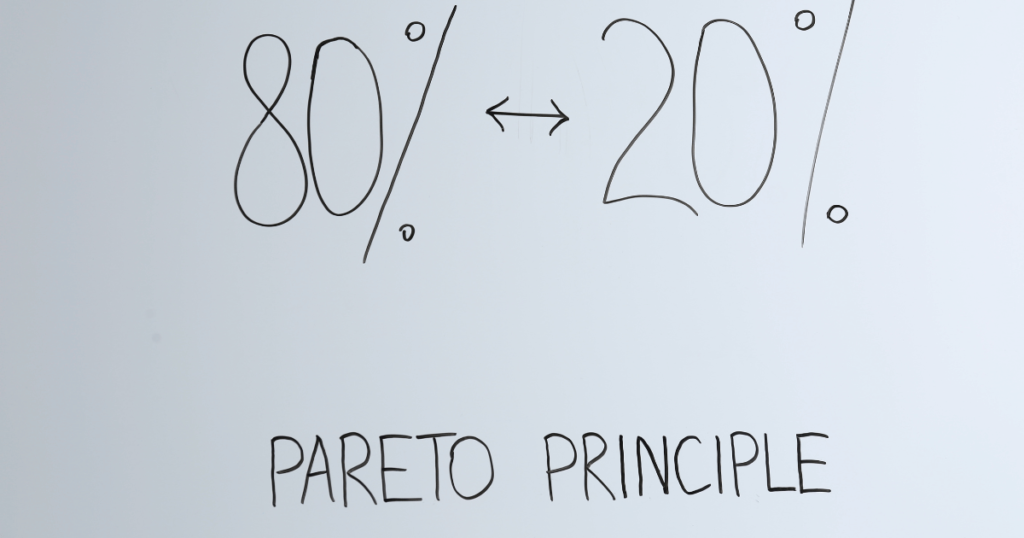Each one of us has different responsibilities in the family and at work. But sometimes, we mess up things because of a lack of planning.
Here comes the role of time management, as most people tend to spread out their time instead of focusing on the most important tasks.
One popular technique is the Pareto principle, the 80/20 rule.
However, it is essential to use a few techniques to identify which task needs to be done first.
What is the Definition of the Pareto Principle?
This technique can help you to prioritize your highest-impact tasks, increasing your daily productivity.

Pareto’s principle states that 80% of your output could come from only 20% of your time at work. It is just in 3 steps.
- 1. Identify Key Tasks: A focused and strategic approach to your work can lead to significant outcomes.
- 2. Prioritize Effectively: After identifying the most important tasks, prioritize those that contribute the most value.
- 3. Time Management: Allot a substantial portion of your time and energy to critical tasks. This doesn’t mean neglecting other responsibilities but ensuring you distribute your resources efficiently.
What is the 80/20 rule:Understanding the Pareto Principle
The Pareto principle was developed in 1896 by Italian economist Vilfredo Pareto. He carefully did a study and came up with 2 observations.
1.80% of the land in Italy was owned by only 20% of the population.
2. He also observed this with plants in his garden—20% of his plants bore 80% of the fruit.
Then, he came up with a formula that states the best way to represent this correlation directly. It is a power law distribution between two quantities, where changes in one cause corresponding changes in the other.
Application of the Pareto Principle
The Pareto Principle can be applied in multiple aspects of our lives, such as manufacturing, management, and human resources.
It can also be applied on a personal level, 1 simple trick to achieve more with less effort.
The 80/20 rule will help you and your team achieve more while correctly implementing it.

➨ 20% of your serious effort will produce 80% of your results.
➨ 20% of issues will form 80% of your headaches.
➨ 20% of your customers lead to 80% of your profits.
Master identifying the 20% that matters most; it is the key to being more productive without burning out, and you will be surprised at how much more you will do.
The examples go on. Remember that the Pareto Principle does not necessarily suggest that you work 20 percent of the time or visit the workplace one day a week. It is also crucial to emphasize that the Pareto Principle does not suggest that you work less.
Instead, the Pareto Principle can help you identify the things you should prioritize in order to optimize your time and productivity when you apply the 80/20 Rule to your workday. Put another way, put more effort into the most crucial jobs and do not worry about the small stuff.
The Pareto Principle, on the other hand, does not only relate to overall outcome observations; rather, the 80/20 Rule may be used in practically every aspect of your workday to help maximize efforts and productivity.
Benefits of the Pareto Principle
There is a practical reason for using the Pareto Principle. In other words, it might serve as a window into what needs to be fixed.
In the workplace: Sometimes, a small percentage of your coworkers significantly contribute to a project’s positive environment or success.
This 20% could be the individuals who bring innovative ideas, collaborate effectively, and foster a positive team culture.
In professional network: You may discover that a small percentage of your connections add the most value to your career.
These could be mentors, influencers, or colleagues with whom you share mutual support and collaboration; focusing on developing and maintaining these key relationships can have a greater impact on your professional growth.
In personal relationships: Do you know that only a small percentage of your friends or family members contribute significantly to your happiness and well-being?
These could be the people who provide emotional support, understanding, and genuine connection. Recognizing and appreciating these key relationships can lead to a more fulfilling personal life.
In Marketing and Sales: If there are 20% of your customers who drive 80% of your sales, you should focus on those customers and reward them for their loyalty.
So, spending quality time with a small percentage of individuals produces the most meaningful and fulfilling experiences, allowing you to invest your time and energy more efficiently.
Conflict Resolution: The 80/20 rule may suggest that a small percentage of issues or individuals contribute to most problems in conflicts or disagreements.
Identifying and addressing these core issues or individuals can lead to more effective conflict resolution and a healthier overall relationship.
Disadvantages of the Pareto Principle
It is crucial to keep in mind that the Pareto Principle helps you identify the most important, high-impact tasks on your to-do list.
Do not ignore the smaller, less important tasks; if you let them sit for too long, they will eventually become important.
The Pareto Principle constitutes only an observation and is not a law. So, it does not mean it is always true. Remember that the 20% and 80% numbers are estimates and observations rather than precise statistics.
Wrap up
Identifying the significant impact of a 20% time allocation allows us to prioritize, nurture meaningful connections, and address core issues.
Apply this 80/20 principle to promote a healthy approach in relationships. For productivity and overall success, whether at work or in personal life.
FAQ’S
1.What are some examples of the Pareto rule at work?
- Business: 20% of customers create 80% of sales.
- Productivity: 20% of tasks result in 80% of outcomes.
- Fitness: 20% of workouts give 80% of health benefits.
2.I want to know how to handle problems when using the Pareto rule.
- Start Small: Find one or two areas where you can change.
- Be Realistic: Set goals you can reach and do not aim for perfection.
- Track Your Progress: Watch how you are doing and change things if needed.
- Stay Open: Be willing to change your plan if things around you change.
3.Is the Pareto Principle always accurate?
The 80/20 rule is a simple guideline. The specific amounts can change depending on the situation. However, the main idea of focusing on important tasks is helpful.


